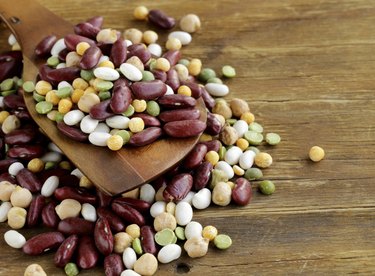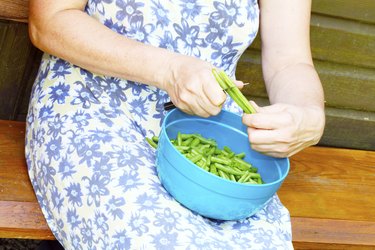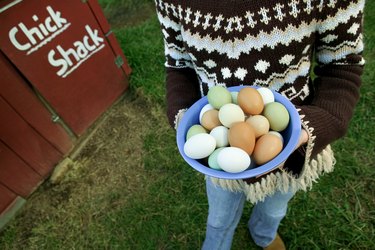
Raw diets prohibit cooked foods. One reason behind the raw philosophy is that cooking sometimes destroys foods' important vitamins and enzymes. While you cannot cook your food if you follow a raw diet, you can prepare it. If its temperature is kept below 115 degrees Fahrenheit, it's still considered raw.
Raw Diets
Video of the Day

You can enjoy beans and other legumes on a raw diet. But dry legumes are almost impossible to chew, so you need to prep them beforehand. Furthermore, dried beans contain compounds that inhibit healthy enzyme function and that, occasionally, house toxins. Cooking destroys these compounds. But since a raw diet prohibits cooking, you will need to destroy or remove the toxins and inhibitors another way. Two common methods to prepare beans include letting them soak or sprouting them. The latter technique is equally as effective in controlling the enzyme inhibitors and toxins as cooking is.
Video of the Day
Prepared beans and other legumes are constituents of many raw dishes. Raw hummus, for example, can be made by blending prepared chickpeas, lime, orange juice, garlic and tahini; and black bean dip can be made by mixing prepared black beans, minced tomatoes, onion, cumin, cayenne and garlic. Crackers and bread for dipping can be prepared in a dehydrator that blows air through the food to remove moisture.
Foods to Avoid

Though you can eat almost anything on a raw diet as long as the food is not cooked, there are some exceptions. Raw eggs and raw meat can contain dangerous bacteria and worms. Some raw vegetables, too, can be risky. Mushrooms found in forests can be poisonous, and unprepared beans contain molecules that can inhibit enzymes important for cell growth.
It is, however, important to include beans in a raw diet, especially in a raw vegan or vegetarian diet, as they are one of the most important sources of protein and fiber.
How to Soak Beans

One way to prepare beans for use in raw dishes is to soak them for 24 to 48 hours in cold water. Soaking them can neutralize enzyme inhibitors and toxins and make them easier to digest. To soak, place the beans in cold water in a container, cover with a lid and let sit on the countertop. Pour out the water and rinse the beans every couple of hours during the day to remove toxins. After rinsing, add fresh water. When the beans are soft enough to bite into, they are ready for use.
How to Sprout Beans
Even after soaking, uncooked legumes can still be quite rough on the digestive system. Sprouted legumes are easier to digest and easier to use in spreads, dips and soups. To sprout, rinse the legumes, put them in a glass jar and cover with tulle netting fastened with a rubberband. Keep the legumes moist but not soaking wet. Rinse them often to prevent mold growth. Sprouting time depends on how starchy the legume is, but on average, legumes sprout after one to five days: After a day or two, green or white sprouts will appear on the legumes. When the sprouts are about a quarter to to a half inch long, the legumes are ready for use. After sprouting, rinse the legumes again to get rid of some of the indigestible sugars that can give rise to gas.